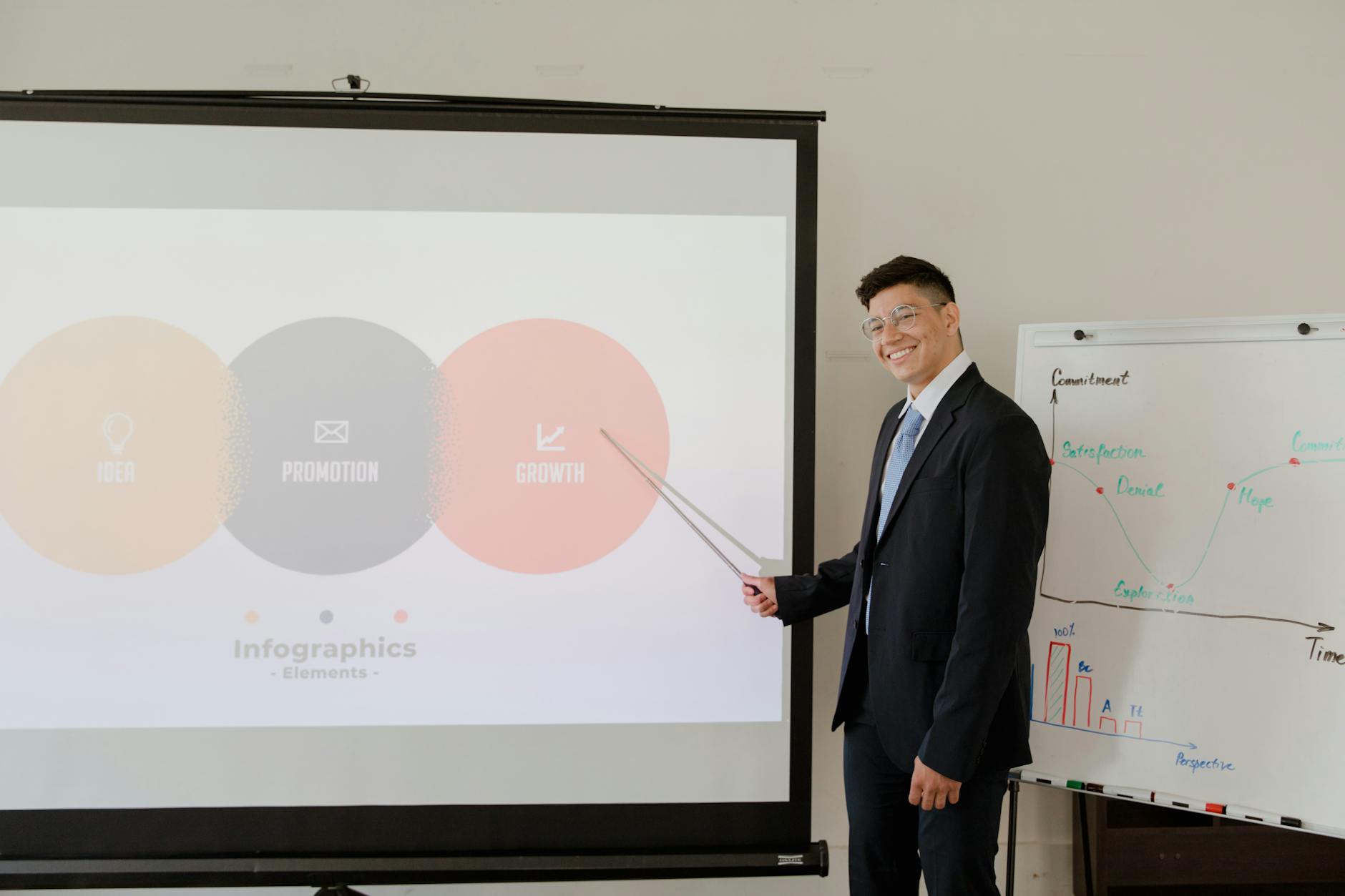Keys to Hosting Webinars That Generate Leads and Boost Brand Growth
Webinars have become one of the most effective tools for brands to connect with their audience and generate leads. Done well, they showcase expertise, build trust, and provide real value to potential customers. But the success of a webinar hinges on thoughtful planning, engaging content, and an understanding of your target audience. When approached with the right strategy, webinars can not only drive leads but also position your brand as a go-to authority in your industry.
Define Your Objectives
Setting clear objectives is the cornerstone of any successful webinar. Without a defined purpose, it’s easy to lose focus, which can lead to a lacklustre event that doesn’t resonate with your audience or meet your brand’s goals. This section will walk you through the process of identifying your target audience and establishing measurable goals.
Identify Your Target Audience
Understanding who your audience is can make or break your webinar. Crafting a message that hits the mark starts with knowing your audience’s demographics, interests, and pain points. But how exactly can you identify them?
- Research Your Current Customers: Review your existing customer base. What problems are they solving with your product or service? Use this information as a foundation for your webinar content.
- Analyse Social Media Insights: Platforms like LinkedIn, Instagram, and Twitter offer helpful demographic and engagement data. Dive into these insights to see who follows you and what they’re engaging with.
- Use Surveys or Polls: Sometimes, the best way to understand your audience is to ask. Online surveys or social media polls can uncover key areas of interest.
- Consider Buyer Personas: If you already use buyer personas, mould your webinar to fit the needs of these profiles. If not, this might be the time to develop them.
For more tips on targeting your webinar, check out How To Define and Target a Webinar Audience.
Set Measurable Goals
Once you’ve pinpointed your audience, the next step is defining measurable goals for your webinar. Why? Because vague ideas, like “engage customers,” won’t help you track success.
Start with the SMART framework. This method ensures your goals are:
- Specific: Be clear about what you plan to achieve. For example, “Generate 200 leads,” rather than “Get leads.”
- Measurable: Attach metrics to your goals. A webinar goal should be something you can quantify.
- Achievable: Make sure the goals are realistic given your resources, audience, and timeline.
- Relevant: Focus on objectives that align with your larger marketing strategy or business priorities.
- Time-Bound: Set a clear deadline. Whether it’s pre-webinar sign-ups or post-event conversions, know your timeline.
Examples of measurable webinar goals include:
- Lead Generation: Collect email addresses or contact details of attendees.
- Brand Awareness: Increase social media followers or webinar landing page visits.
- Sales Enablement: Promote a product or service by showcasing a demo.
For more insights on setting webinar objectives, read How to Set Realistic Webinar Goals & Objectives.
Pinpointing your audience and laying out measurable goals creates the foundation for a well-curated webinar. Next, we’ll move into steps to ensure your content truly engages and converts viewers into leads.

Photo by cottonbro studio
Create Engaging Content
Creating engaging content is the heart of any successful webinar. Your audience attends because they want insights—they’re investing their time in exchange for value. To keep them hooked, every element of your content should not only resonate but also provide actionable takeaways. Here’s how you can enhance your webinar content to ensure it captivates and convinces.
Tailor Content to Audience Needs
Understanding your audience’s needs should be at the forefront of your content strategy. Whether your viewers are new prospects or returning customers, aligning your content with their pain points and interests makes your webinar feel personally relevant. But how can you craft content that truly speaks to your audience?
- Start with Audience Research: Leverage tools like surveys, social media polls, and email feedback to discover what your audience actually wants. Align your findings with the webinar’s objective.
- Provide Solutions, Not Just Information: People don’t want fluff. Address their challenges directly with practical, real-world solutions. Think “how-to” guides, case studies, or actionable frameworks.
- Simplify Complex Ideas: Break complicated concepts into digestible points, using analogies or examples from everyday life. The simpler the explanation, the more likely it will resonate.
When you connect with your audience on this level, they’ll not only engage but also feel more inclined to trust your brand. For further insight, check out 15 Tips to Make an Engaging Webinar.
Utilise Compelling Visuals
Imagine scrolling through a presentation filled with endless text—it’s a surefire way to lose focus. This is where visuals step in, making your content clearer and more engaging.
- Use Slides Strategically: Split information into sections, each with its own slide. Keep text minimal, use large fonts, and let images lead the narrative.
- Incorporate Infographics and Charts: Transform stats or detailed data into visuals. It’s faster for people to understand patterns, trends, and comparisons.
- Leverage Video Clips or GIFs: A short video or dynamic animation can demonstrate an idea much more effectively than words.
Visual content doesn’t just make your presentation look better—it enhances comprehension and memory retention. Learn more about the importance of visuals in webinars in The Ultimate Guide to Webinar Visuals.

Photo by Sam Lion
Include Interactive Elements
Today’s webinar attendees expect more than a passive viewing experience—they want opportunities to participate and interact. Including interactive elements can elevate engagement levels to new heights.
- Add Real-Time Polls: Use live polls to gauge audience opinion or knowledge, making your webinar feel collaborative.
- Host Live Q&A Sessions: Set aside dedicated time for questions at the end of your session or, better yet, take questions as they arise.
- Encourage Chat Discussions: Prompt attendees to leave comments or share thoughts in the chatbox. By doing so, you create a sense of community.
- Gamify the Experience: Adding quizzes or challenges fosters light-hearted competition, keeping energy levels high.
People are far more likely to remember your webinar if they felt involved, not just spoken to. Want to learn more? Check out expert strategies on 7 Strategies to Make Your Webinar More Interactive in 2023.
Interactive elements are no longer a “nice-to-have”; they’re essential for fostering strong engagement and building deeper connections with your audience. Keep the conversation flowing, and watch your leads multiply.
Select the Right Webinar Format
The format of your webinar is just as important as its content. Your choice impacts audience engagement, the ease of delivery, and the overall experience. Let’s break this down into key options that should shape your decision-making.
Live vs. Recorded Webinars: Explore the benefits of both formats
When it comes to webinars, choosing between live and recorded formats depends on your brand’s goals and audience preferences. Here’s a closer look at each option:
- Live Webinars: Ideal for creating authentic, real-time connections. These sessions allow direct interaction, such as live Q&A sessions or polls. They’re great for building trust and fostering two-way communication, but they require strong preparation and on-the-spot adaptability.
- Recorded Webinars: Perfect for on-demand viewing. Pre-recorded sessions offer polished content and flexibility, enabling attendees to watch at their convenience. However, they lack the spontaneity and personal touch of live events.
When deciding, consider your audience. If they value flexibility, a recorded format might work best. If engagement is your priority, live events are unmatched. For more insights, check out Live vs Pre-Recorded Webinars: Pros and Cons.
Panel Discussions and Interviews: Highlight how diverse viewpoints can add value
Incorporating panel discussions or interviews into your webinar format is an excellent way to introduce diverse perspectives and valuable expertise. These formats break up the monotony of a single speaker, offering a dynamic and engaging experience for attendees.
- Panel Discussions: Featuring multiple experts sharing insights fosters a well-rounded dialogue on your chosen topic. A skilled moderator is key to keeping the conversation flowing and ensuring each panellist gets to shine.
- Interviews: A focused Q&A with a single industry leader creates a more intimate, storytelling-style session. This format is perfect for in-depth exploration without overwhelming the audience.
These formats also lend credibility to your brand, as they showcase thought leaders who reinforce your expertise. For tips on hosting successful panel discussions, explore How to Host Successful Webinar Panel Discussions.

Photo by SHVETS production
By carefully choosing your webinar format, you can enhance the experience for your audience while achieving your event’s intended goals.
Effective Promotion Strategies
A well-promoted webinar can transform a handful of registrations into a sold-out online event. Promotion isn’t just about shouting louder; it’s about being strategic with your resources and reaching your audience where they are. The following strategies will ensure your event gets maximum visibility and engagement.
Leverage Social Media
Social media platforms are where attention lives today, making them vital to any webinar promotion plan. Different platforms cater to varied audiences, so tailoring your approach is critical.
- Facebook: Use event creation tools to notify followers of your upcoming webinar. Boosting posts or running targeted ads can amplify your reach. Posts with short, engaging videos or imagery tend to perform best.
- LinkedIn: For professional audiences, nothing beats LinkedIn. Share posts on your company page, encourage team members to post about the event, and even consider LinkedIn Ads for a highly targeted campaign. Create updates that highlight how the webinar will address common challenges.
Consistency is key. An effective social media campaign involves posting at least three times before the event: once to announce, once as a reminder, and finally on the day to entice last-minute signups. For more tips on social media promotion, check out Effective Ideas to Promote Your Webinar.

Photo by RDNE Stock project
Email Marketing Campaigns
Email marketing remains one of the most direct and effective ways to reach your audience. If done right, it can turn cold leads into eager attendees.
- Segment Your List: People are more likely to engage with emails that feel personal. Divide your email list based on customer types, industries, or interests, and tailor your messaging accordingly.
- Timing Matters: Send promotional emails in phases—for example, an invitation three weeks out, a reminder a week before, and a final push on the day of the webinar.
- Create Click-Worthy Subject Lines: Subject lines are your first impression; make them short, clear, and enticing. Test subject lines like, “How to Solve [Pain Point] in One Webinar,” to increase open rates.
- Use Visuals and CTAs: Add compelling images, concise descriptions, and clear call-to-action buttons. Include direct links to the registration form to remove friction.
Use analytics to refine your emails. Track open rates, click-throughs, and conversions, adjusting content where necessary. Learn more with How to Promote a Webinar with Email Marketing.
Collaboration with Influencers
Teaming up with influencers can exponentially boost your webinar’s visibility. An influencer brings credibility and access to an audience that already trusts their recommendations.
- Choose Relevant Influencers: Not every influencer fits your brand. Prioritise those whose followers align with your target audience, ensuring the collaboration feels authentic.
- Create Value for Their Audience: Influencers are more likely to promote your webinar if they see clear benefits for their followers. Share snippets of what participants will gain or insights from your webinar that can be teased pre-event.
- Involve Them Creatively: Let influencers co-host, moderate, or even speak at your webinar. This adds star power and gives their audience a reason to attend.
For even more insights on influencer collaboration, visit Boost Your Webinar Audience Growth with Influencers and Content Creators.
Each of these strategies is powerful on its own. Together, they create a robust promotional campaign to ensure your webinar is not just another event but a must-attend experience for your audience.
Engage Participants During the Webinar
Keeping your audience engaged during a webinar is key to its success. If attendees feel disconnected or disinterested, the chances of them converting into leads drastically drop. The best webinars are those where the attendees actively participate, feel heard, and leave with valuable insights. Let’s explore how to engage participants and measure their interest effectively during the event.
Encourage Questions and Feedback
One of the simplest yet most effective ways to keep your audience involved is by inviting their questions and feedback. A webinar isn’t just a presentation; it’s a two-way conversation that thrives on interaction. But how do you make this happen?
- Create Open Q&A Sessions: Reserve time at the midpoint or end of your session to answer audience questions. This demonstrates you value their input while keeping the webinar dynamic.
- Use Real-Time Chat Tools: Encourage participants to share opinions or ask questions throughout the session using a chat feature. A lively chat can make the experience feel communal and energising.
- Introduce Polls or Surveys: Deploy quick polls during your session to gauge audience sentiment or understanding. For example, “How familiar are you with [topic X]?” provides valuable feedback and makes attendees feel involved.
- Respond in Real Time: Show you’re listening by addressing comments or questions as they come in. Acknowledge people by name when possible—it adds a personal touch.
Want more actionable tips? Check out these effective webinar engagement strategies to captivate your audience.
 Photo by RDNE Stock project
Photo by RDNE Stock project
Monitor Engagement Metrics
Evaluating engagement isn’t just important for your webinar’s success—it’s essential for improving future sessions. But which metrics should you monitor during the event to accurately measure audience interest?
- Chat and Q&A Interaction Levels: Count the number of chats, comments, and questions submitted. Frequent participation is a sign your audience is paying attention and finding value.
- Attendance Retention Rates: Track how long participants stay tuned in. A high drop-off rate might indicate low engagement or a mismatch between their expectations and your content.
- Poll Response Rates: If you’re using polls, measure how many attendees participate. High response rates can indicate that your audience feels involved.
- Download or Link Clicks: Offering downloadable resources or sharing links? Check how many users take action—it’s an immediate sign of interest.
Each of these metrics provides insight into how connected your attendees are to your content. For a deeper dive into which metrics to prioritise, check out webinar metrics for measuring engagement.
Strong engagement ultimately separates an average webinar from a memorable one. By fostering interaction and monitoring key metrics, you’ll be on a clearer path to converting attendees into warm, qualified leads.
Follow Up After the Webinar
Wrapping up your webinar doesn’t mean the end of the engagement. In fact, the post-webinar phase is where you nurture leads and deepen connections. Following up effectively not only keeps the conversation going but also cements your brand in the minds of attendees. Here are three core actions to include in your follow-up plan.
Send Thank You Emails
A thank-you email is more than good manners—it’s a strategic move to show appreciation while keeping the momentum alive. This simple gesture lets your attendees know their participation matters.
- Balance Personalisation with Automation: While reaching out to all participants may seem daunting, it can be streamlined with email automation. Use personalisation tools to include their names and, if possible, specific takeaways they might have found valuable.
- Include Key Information: Add links to the webinar recording, key points discussed, or even a summary of the event. This ensures those who missed certain insights get to revisit the value you offered.
- Call to Action (CTA): Don’t stop at gratitude. Encourage further engagement—a chance to book a consultation, download a related resource, or register for future events.
For a more in-depth guide to follow-up emails, read 7 Webinar Follow-Up Templates to Increase Webinar Impact.
Share Recorded Sessions
A recorded webinar isn’t just a recap; it’s an asset that can continue to work for your brand long after the event. Sharing it opens doors to broader audiences and keeps leads flowing.
- Make It Easily Accessible: Host the recording on your website, YouTube channel, or use a dedicated webinar platform. Send a direct link to attendees and anyone who registered but didn’t show up.
- Repurpose for Content: Break down the recording into bite-sized clips to share on social media. Highlight specific points that address common challenges or FAQs from your audience.
- Leverage SEO: Optimise the video’s title, description, and tags with relevant keywords so potential leads can discover it organically.
For more strategies on webinar recordings, check out How to Use Prerecorded Webinars to Generate Leads.

Photo by RDNE Stock project
Provide Additional Resources
Offering extra resources post-webinar adds immense value. Attendees are already in a learning mindset, which makes this the perfect time to share tools that address their pain points.
- E-books and Guides: Curate in-depth materials related to the webinar topic that attendees can download and return to when needed.
- Exclusive Content: Provide gated content like infographics, templates, or case studies that expand on what the webinar covered. This not only adds value but gives you insights into which leads are the most engaged.
- Next Steps: Offer clear guidance on how they can continue their journey with your brand, whether via your products, services, or upcoming events.
Dive deeper into follow-up strategies with Post-Webinar Best Practices: How to Keep the Momentum Going.
By focusing on these follow-up steps, you maintain audience interest and build stronger relationships that convert leads into loyal customers. The real work often begins after the webinar ends—make every interaction matter!
Conclusion
Webinars are a powerful tool to generate leads and strengthen your brand’s presence, but success demands careful planning and execution. Focus on aligning your goals, tailoring content to audience needs, and leveraging engaging formats. Don’t overlook post-event follow-ups—they can convert attendees into loyal customers.
Start applying these strategies today. Your next webinar could be the keystone to driving growth and building lasting relationships.










